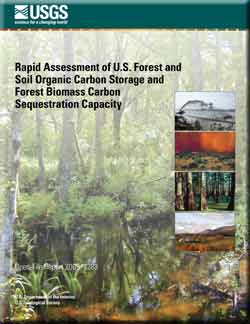Open-File Report 2009–1283
1U.S. Geological Survey, Woods Hole
2ASRC Research and Technology Solutions, contractor to the U.S. Geological Survey EROS Data Center, Sioux Falls, SD
3Woods Hole Research Center, Falmouth, MA
4U.S. Department of Agriculture, Forest Service, Rocky Mountain Research Station, Missoula Fire Sciences Laboratory, Missoula, MT
5U.S. Geological Survey, EROS Data Center, Sioux Falls, SD
ABSTRACT
This report provides results of a rapid assessment of biological carbon stocks and forest biomass carbon sequestration capacity in the conterminous United States. Maps available from the U.S. Department of Agriculture are used to calculate estimates of current organic carbon storage in soils (73 petagrams of carbon, or PgC) and forest biomass (17 PgC). Of these totals, 3.5 PgC of soil organic carbon and 0.8 PgC of forest biomass carbon occur on lands managed by the U.S. Department of the Interior (DOI). Maps of potential vegetation are used to estimate hypothetical forest biomass carbon sequestration capacities that are 3–7 PgC higher than current forest biomass carbon storage in the conterminous United States. Most of the estimated hypothetical additional forest biomass carbon sequestration capacity is accrued in areas currently occupied by agriculture and development. Hypothetical forest biomass carbon sequestration capacities calculated for existing forests and woodlands are within ±1 PgC of estimated current forest biomass carbon storage. Hypothetical forest biomass sequestration capacities on lands managed by the DOI in the conterminous United States are 0–0.4 PgC higher than existing forest biomass carbon storage. Implications for forest and other land management practices are not considered in this report. Uncertainties in the values reported here are large and difficult to quantify, particularly for hypothetical carbon sequestration capacities. Nevertheless, this rapid assessment helps to frame policy and management discussion by providing estimates that can be compared to amounts necessary to reduce predicted future atmospheric carbon dioxide levels. |
First posted December 2009 For additional information contact: Part or all of this report is presented in Portable Document Format (PDF); the latest version of Adobe Reader or similar software is required to view it. Download the latest version of Adobe Reader, free of charge. |
Sundquist, E.T., Ackerman, K.V., Bliss, N.B., Kellndorfer, J.M., Reeves, M.C., and Rollins, M.G., 2009, Rapid assessment of U.S. forest and soil organic carbon storage and forest biomass carbon sequestration capacity: U.S. Geological Survey Open-File Report 2009–1283, 15 p., available at https://pubs.usgs.gov/ofr/2009/1283/.
Abstract
Introduction
Data and Methods
Soil Organic Carbon
Biomass and Carbon in Existing Forest Vegetation
Biomass and Carbon in Potential Vegetation
The LANDFIRE Dataset
Potential Forest Vegetation Biomass and Carbon
Land Cover and Land Use
Lands Managed by the U.S. Department of the Interior
Results and Discussion
Limitations of this Assessment
Implications of this Assessment
Acknowledgments
References Cited